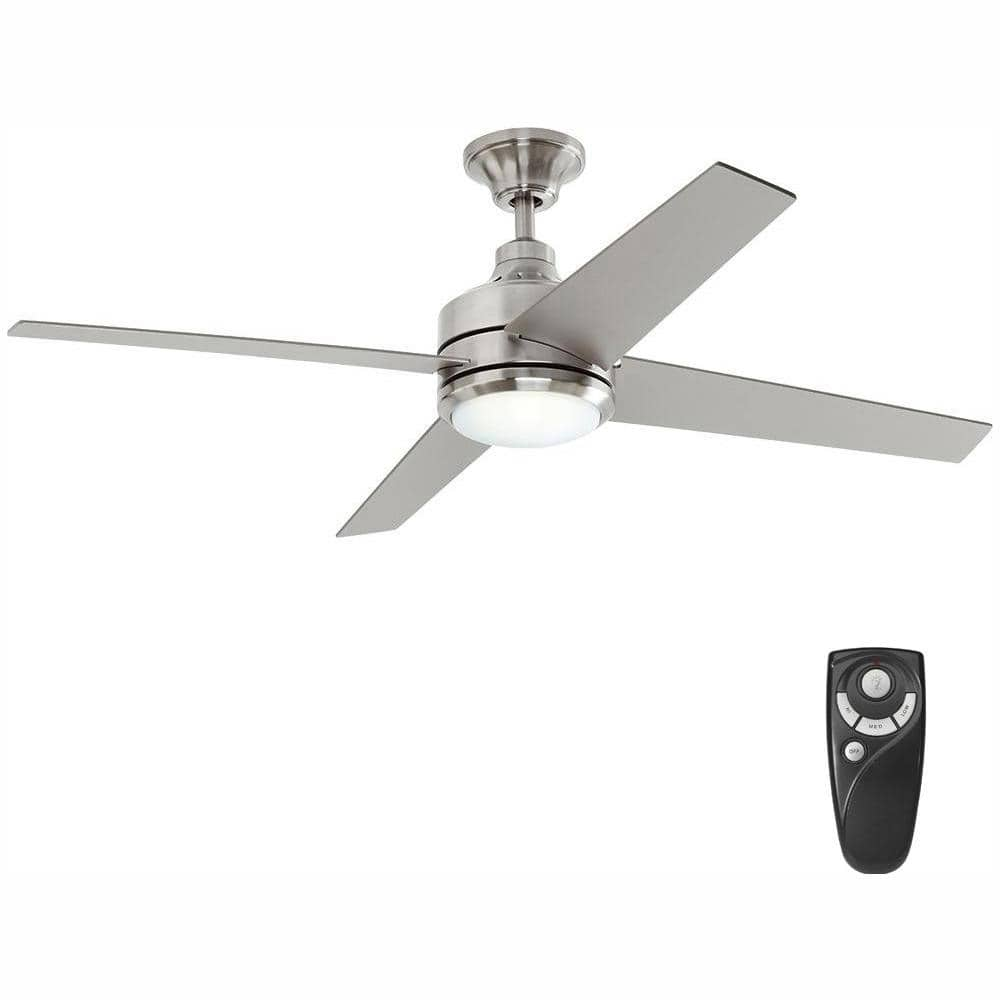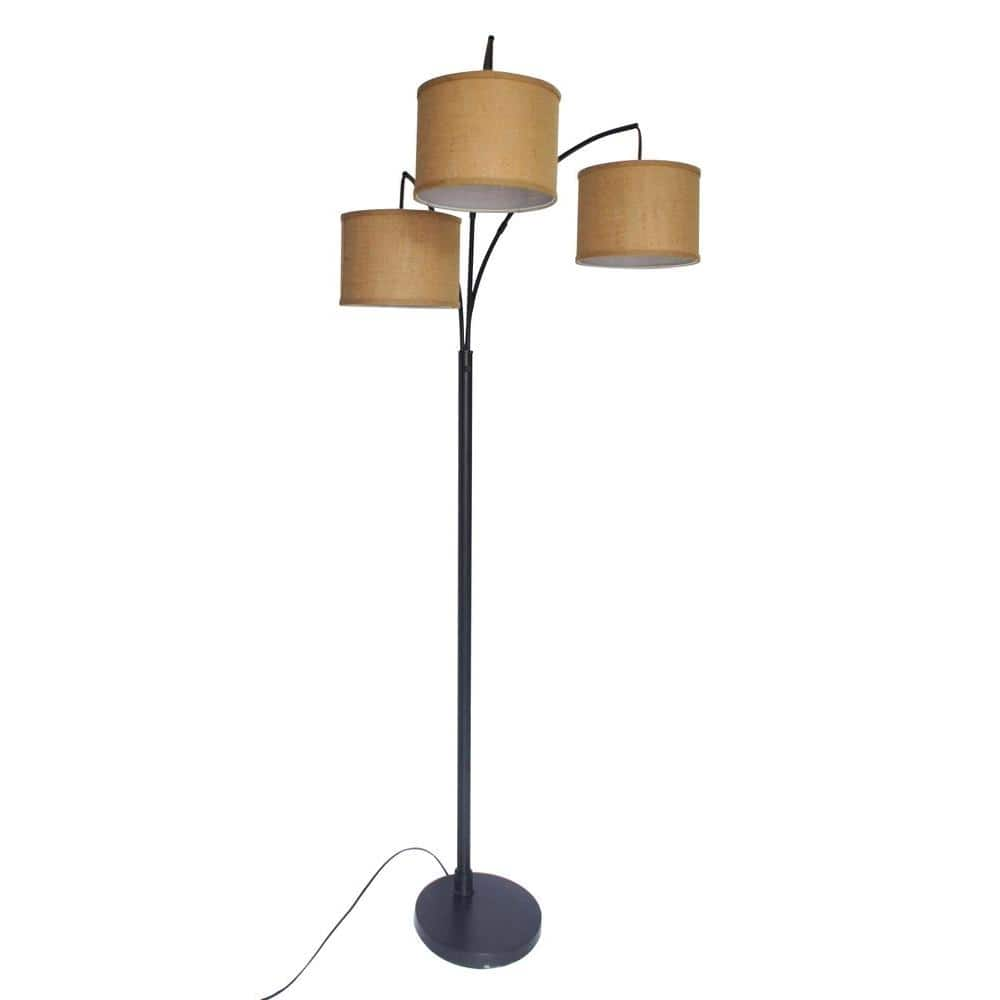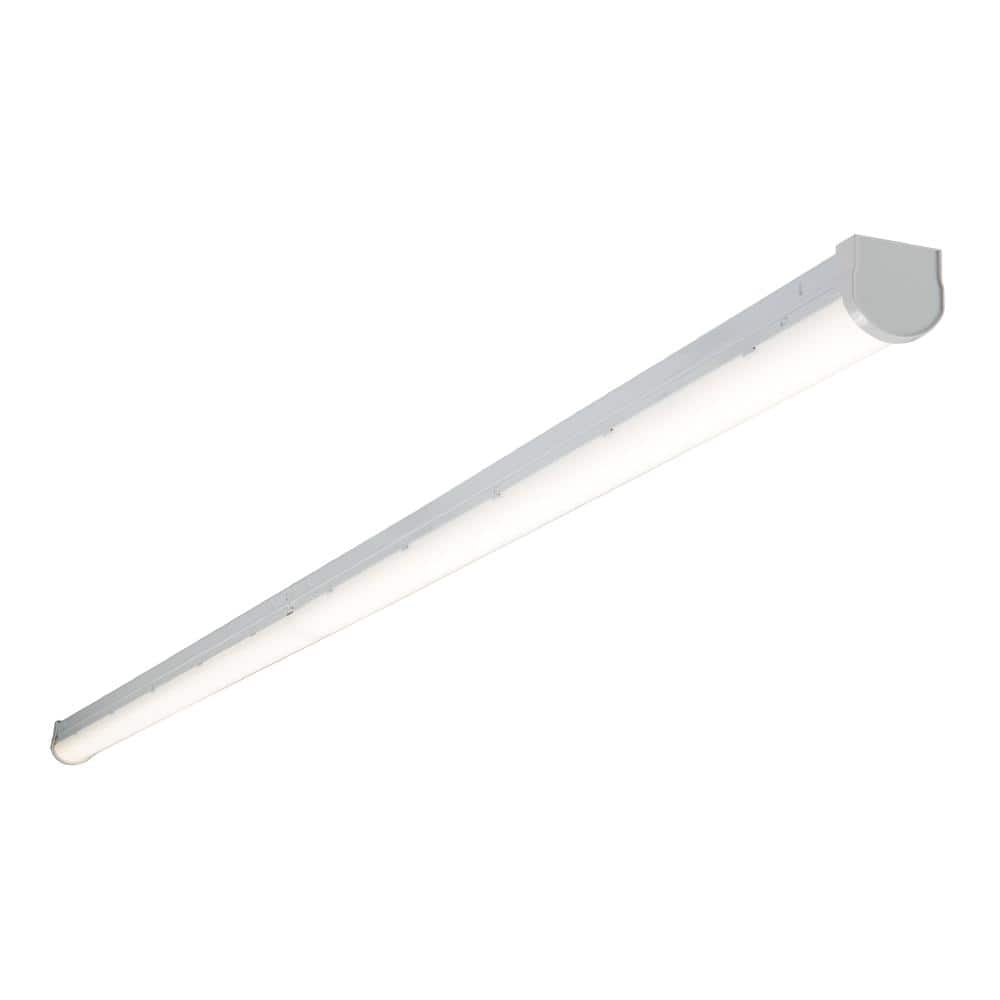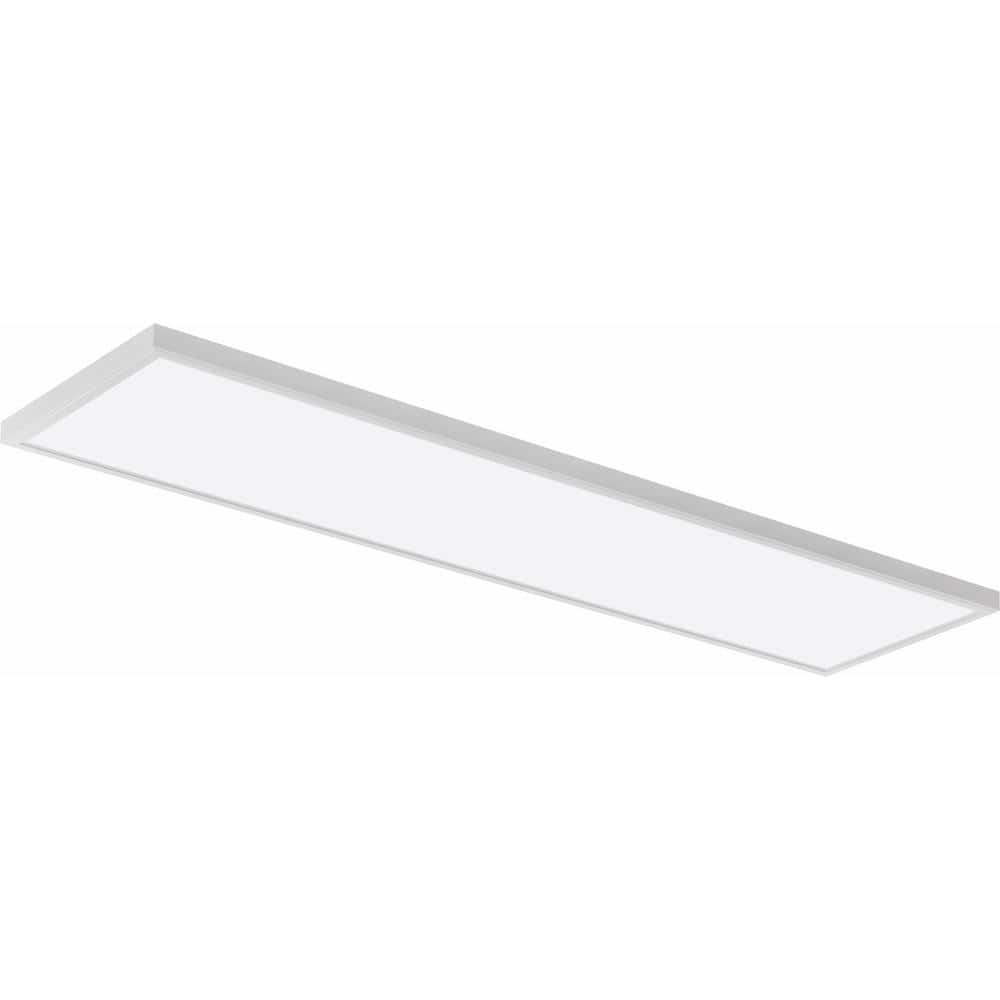Home Decorators Collection Mercer 52 in. LED Indoor Brushed Nickel Ceiling Fan with Light Kit and Remote Control
Adds a contemporary and modern style to your living space. Ideal ceiling fan for large rooms up to 20 ft. x 20 ft. Includes integrated LED light kit, remote control, and downrod.
Add a contemporary look to your home with the Home Decorators Collection Mercer 52 in. LED Brushed Nickel Ceiling Fan. This 3-speed fan features 4-blades to help move air efficiently, with quiet, wobble-free operation. This fixture offers an integrated light covered by an etched opal glass and includes a 20-Watt LED integrated module. If you’re tired of using the remote control and you want to include your traditional ceiling fan in your automated home system, the Bond is the simplest and quickest way to do so. Bond Smart Wifi Fan Remote Hub, it enables you to control your fan, along with the lighting that goes with it. Bond is compatible with Amazon Echo and Google Home when used. Bond works with Alexa and other compatible smart home products. (Bond sold separately).
- 4 silver blades with 14° blade pitch for greater air movement
- Brushed nickel finish complements a variety of decor styles
- 172 mm x 20 mm motor offers superior air movement, 5423 CFM airflow
- Ideal for large rooms up to 20 ft. x 20 ft. with blade sweep of 52 in
- Threaded 4.5 in. downrod and coupler for safety and stability
- Tri-mount installation
- Quiet motor technology PLUS produces more airflow with less noise
- Slide on bracket makes installing a breeze
- Includes downrod and remote control
- Controls your fan via a bond smartphone app
- Light and speed control
- Bond smart remote makes your ceiling fan smart with no rewiring
- WWB: Works with bond seamless one-click integration
- Bond sold separately
Additional information
| Dimensions | H 15 in, W 52 in, D 52 in |
|---|---|
| Downrod Length (in.) | 4.5 |
| Fan Blade Length (in.) | 22.68 |
| Fan Blade Span (in.) | 52 |
| Fan Blade Width (in.) | 5.71 |
| Certifications and Listings | UL Listed |
| Manufacturer Warranty | 1 Year Limited Warranty |
52 may refer to:
- 52 (number)
- one of the years 52 BC, AD 52, 1952, 2052
- 52-hertz whale an individual male whale, also known as the loneliest whale, calling at the unusual 52 hertz range
- 52 (comics), a 2006–07 American weekly comic book series
- 52 (album series), series of albums by American singer Kristian Bush
- 52 Europa, a main-belt asteroid
- Tatra 52, a mid-size car
A ceiling is an overhead interior roof that covers the upper limits of a room. It is not generally considered a structural element, but a finished surface concealing the underside of the roof structure or the floor of a story above. Ceilings can be decorated to taste, and there are many examples of frescoes and artwork on ceilings, especially within religious buildings. A ceiling can also be the upper limit of a tunnel.
The most common type of ceiling is the dropped ceiling, which is suspended from structural elements above. Panels of drywall are fastened either directly to the ceiling joists or to a few layers of moisture-proof plywood which are then attached to the joists. Pipework or ducts can be run in the gap above the ceiling, and insulation and fireproofing material can be placed here. Alternatively, ceilings may be spray painted instead, leaving the pipework and ducts exposed but painted, and using spray foam.
A subset of the dropped ceiling is the suspended ceiling, wherein a network of aluminum struts, as opposed to drywall, are attached to the joists, forming a series of rectangular spaces. Individual pieces of cardboard are then placed inside the bottom of those spaces so that the outer side of the cardboard, interspersed with aluminum rails, is seen as the ceiling from below. This makes it relatively easy to repair the pipes and insulation behind the ceiling, since all that is necessary is to lift off the cardboard, rather than digging through the drywall and then replacing it.
Other types of ceiling include the cathedral ceiling, the concave or barrel-shaped ceiling, the stretched ceiling and the coffered ceiling. Coving often links the ceiling to the surrounding walls. Ceilings can play a part in reducing fire hazard, and a system is available for rating the fire resistance of dropped ceilings.
Collection or Collections may refer to:
- Cash collection, the function of an accounts receivable department
- Collection (church), money donated by the congregation during a church service
- Collection agency, agency to collect cash
- Collections management (museum)
- Collection (museum), objects in a particular field forms the core basis for the museum
- Fonds in archives
- Private collection, sometimes just called "collection"
- Collection (Oxford colleges), a beginning-of-term exam or Principal's Collections
- Collection (horse), a horse carrying more weight on his hindquarters than his forehand
- Collection (racehorse), an Irish-bred, Hong Kong–based Thoroughbred racehorse
- Collection (publishing), a gathering of books under the same title at the same publisher
- Scientific collection, any systematic collection of objects for scientific study
Collection may also refer to:
Fan commonly refers to:
- Fan (machine), a machine for producing airflow, often used for cooling
- Hand fan, an implement held and waved by hand to move air for cooling
- Fan (person), short for fanatic; an enthusiast or supporter, especially with regard to entertainment
Fan, FAN or fans may also refer to:
A home, or domicile, is a space used as a permanent or semi-permanent residence for one or more human occupants, and sometimes various companion animals. It is a fully- or semi-sheltered space and can have both interior and exterior aspects to it. Homes provide sheltered spaces, for instance rooms, where domestic activity can be performed such as sleeping, preparing food, eating and hygiene as well as providing spaces for work and leisure such as remote working, studying and playing.
Physical forms of homes can be static such as a house or an apartment, mobile such as a houseboat, trailer or yurt or digital such as virtual space. The aspect of 'home' can be considered across scales; from the micro scale showcasing the most intimate spaces of the individual dwelling and direct surrounding area to the macro scale of the geographic area such as town, village, city, country or planet.
The concept of 'home' has been researched and theorized across disciplines – topics ranging from the idea of home, the interior, the psyche, liminal space, contested space to gender and politics. The home as a concept expands beyond residence as contemporary lifestyles and technological advances redefine the way the global population lives and works. The concept and experience encompasses the likes of exile, yearning, belonging, homesickness and homelessness.
Indoor(s) may refer to:
- the interior of a building
- Indoor environment, in building science, traditionally includes the study of indoor thermal environment, indoor acoustic environment, indoor light environment, and indoor air quality
- Built environment, the human-made environment that provides the setting for human activity
- Indoor athletics
- indoor games and sports
Light, visible light, or visible radiation is electromagnetic radiation that can be perceived by the human eye. Visible light spans the visible spectrum and is usually defined as having wavelengths in the range of 400–700 nanometres (nm), corresponding to frequencies of 750–420 terahertz. The visible band sits adjacent to the infrared (with longer wavelengths and lower frequencies) and the ultraviolet (with shorter wavelengths and higher frequencies), called collectively optical radiation.
In physics, the term "light" may refer more broadly to electromagnetic radiation of any wavelength, whether visible or not. In this sense, gamma rays, X-rays, microwaves and radio waves are also light. The primary properties of light are intensity, propagation direction, frequency or wavelength spectrum, and polarization. Its speed in vacuum, 299792458 m/s, is one of the fundamental constants of nature. Like all types of electromagnetic radiation, visible light propagates by massless elementary particles called photons that represents the quanta of electromagnetic field, and can be analyzed as both waves and particles. The study of light, known as optics, is an important research area in modern physics.
The main source of natural light on Earth is the Sun. Historically, another important source of light for humans has been fire, from ancient campfires to modern kerosene lamps. With the development of electric lights and power systems, electric lighting has effectively replaced firelight.
Nickel is a chemical element; it has symbol Ni and atomic number 28. It is a silvery-white lustrous metal with a slight golden tinge. Nickel is a hard and ductile transition metal. Pure nickel is chemically reactive, but large pieces are slow to react with air under standard conditions because a passivation layer of nickel oxide forms on the surface that prevents further corrosion. Even so, pure native nickel is found in Earth's crust only in tiny amounts, usually in ultramafic rocks, and in the interiors of larger nickel–iron meteorites that were not exposed to oxygen when outside Earth's atmosphere.
Meteoric nickel is found in combination with iron, a reflection of the origin of those elements as major end products of supernova nucleosynthesis. An iron–nickel mixture is thought to compose Earth's outer and inner cores.
Use of nickel (as natural meteoric nickel–iron alloy) has been traced as far back as 3500 BCE. Nickel was first isolated and classified as an element in 1751 by Axel Fredrik Cronstedt, who initially mistook the ore for a copper mineral, in the cobalt mines of Los, Hälsingland, Sweden. The element's name comes from a mischievous sprite of German miner mythology, Nickel (similar to Old Nick). Nickel minerals can be green, like copper ores, and were known as kupfernickel – Nickel's copper – because they produced no copper.
Although most nickel in the earth's crust exists as oxides, economically more important nickel ores are sulfides, especially pentlandite. Major production sites include the Sudbury region, Canada (which is thought to be of meteoric origin), New Caledonia in the Pacific, Western Australia, and Norilsk, Russia.
Nickel is one of four elements (the others are iron, cobalt, and gadolinium) that are ferromagnetic at about room temperature. Alnico permanent magnets based partly on nickel are of intermediate strength between iron-based permanent magnets and rare-earth magnets. The metal is used chiefly in alloys and corrosion-resistant plating.
About 68% of world production is used in stainless steel. A further 10% is used for nickel-based and copper-based alloys, 9% for plating, 7% for alloy steels, 3% in foundries, and 4% in other applications such as in rechargeable batteries, including those in electric vehicles (EVs). Nickel is widely used in coins, though nickel-plated objects sometimes provoke nickel allergy. As a compound, nickel has a number of niche chemical manufacturing uses, such as a catalyst for hydrogenation, cathodes for rechargeable batteries, pigments and metal surface treatments. Nickel is an essential nutrient for some microorganisms and plants that have enzymes with nickel as an active site.
With or WITH may refer to:
- With, a preposition in English
- Carl Johannes With (1877–1923), Danish doctor and arachnologist
- With (character), a character in D. N. Angel
- With (novel), a novel by Donald Harrington
- With (album), a 2014 album by TVXQ
- With (EP), a 2021 EP by Nam Woo-hyun






by Brooklynn
While the light is beautiful, the interactive instructions that the fan/light says to use to install them, left out a few key details that we found once we had gone way past that point. It is a very frustrating light to install, as well.
by Fara
Easy to follow intrux.
by Drake
Looks great, used in bedroom. Issue with fan being on high speed n making some sort of humming noise. Which at night with all the silence in the house tends to be irritating!
by Philip
fan wobbles on high speed. fan light too dim needs to put out more light.
by Joyce
Beautiful contemporary ceiling fan. I bought four of them and love them.
by Angie
Installed fan large living room. Excellent air flow and easy to install. Very happy with my purchase!
by Aussie
This fan moves a lot of air in our hot garage because of the sharply angled fan blades. Our garage is around 500 square feet and the breeze from the fan is able to adequately reach all four walls. Assembly and install was easy and we installed using the wiring where there had previously been a light fitting. The fan comes with a 6 inch downrod which was not long enough to allow the fan to clear the automatic garage door opener motor, so we purchased a 24 inch downrod at Home Depot which worked out perfectly. The fan body is an attractive mid brown in color and matches the color of the wood blades. The light is LED and about equivalent to a 60 watt bulb, more than bright enough to illuminate the space. This fan does not have any pull chains for the light or fan. Instead it is all via a remote which has three speed option for the fan and an on/off for the light. IMPORTANT If you have a Home Decorators ceiling fan that also operates via remote in another area of your home like we do, you will need to change the dip switches on one of the fans so they are not both set the same. When you buy one of these fans the dip switches are all set to the top row and if you don’t change one or other of the remotes, the light will turn on in BOTH locations whenever you use one of the remotes!
by Ronna
These fans are great. They are silent and highly effective.